By: Michele Hamill
Wonderful progress is being made in the A.D. White Library as part of the enormously successful crowd funding campaign to Bring Light to A.D. White. Coordinated by our Facilities staff, the large, ornate study table and the two sets of connected study tables have been beautifully refurbished. Last Fall, we completed the conservation treatment, and archival matting and framing of the original prints and photographs hanging in this historic space.
 Prints and photographs were framed with protective UV-filtering glazing and strategically positioned around the room to minimize light exposure.
Prints and photographs were framed with protective UV-filtering glazing and strategically positioned around the room to minimize light exposure.
Our current work in the A.D. White Library is to stabilize the portrait paintings. While we don’t undertake full conservation of paintings, we can conduct beneficial treatments like surface cleaning to remove dust. The A.D. White Library receives heavy foot traffic since it is a very popular study space and visitor destination. Over time, dust builds up on surfaces, obscuring the paintings and putting them at risk of chemical and physical damage. Removing dust improves the appearance and the stability of the paintings.
 These details show how dust can accumulate, leaving a grey layer over the surface.
These details show how dust can accumulate, leaving a grey layer over the surface.
The oil on canvas portrait of Andrew Dickson White by Truman E. Fassett, was small enough to transport to the Conservation Lab for assessment and treatment. Working closely with us, Rachel Mochon, a Cornell senior majoring in chemistry and the College Scholars Program, documented the condition of this painting using digital photography and examination methods. Her thorough report highlights some minor structural issues that will help us care for this painting in the future.
 The dark background, forward pose, and size of the portrait make the image of Andrew Dickson White appear life-like and connect directly with the viewer.
The dark background, forward pose, and size of the portrait make the image of Andrew Dickson White appear life-like and connect directly with the viewer.
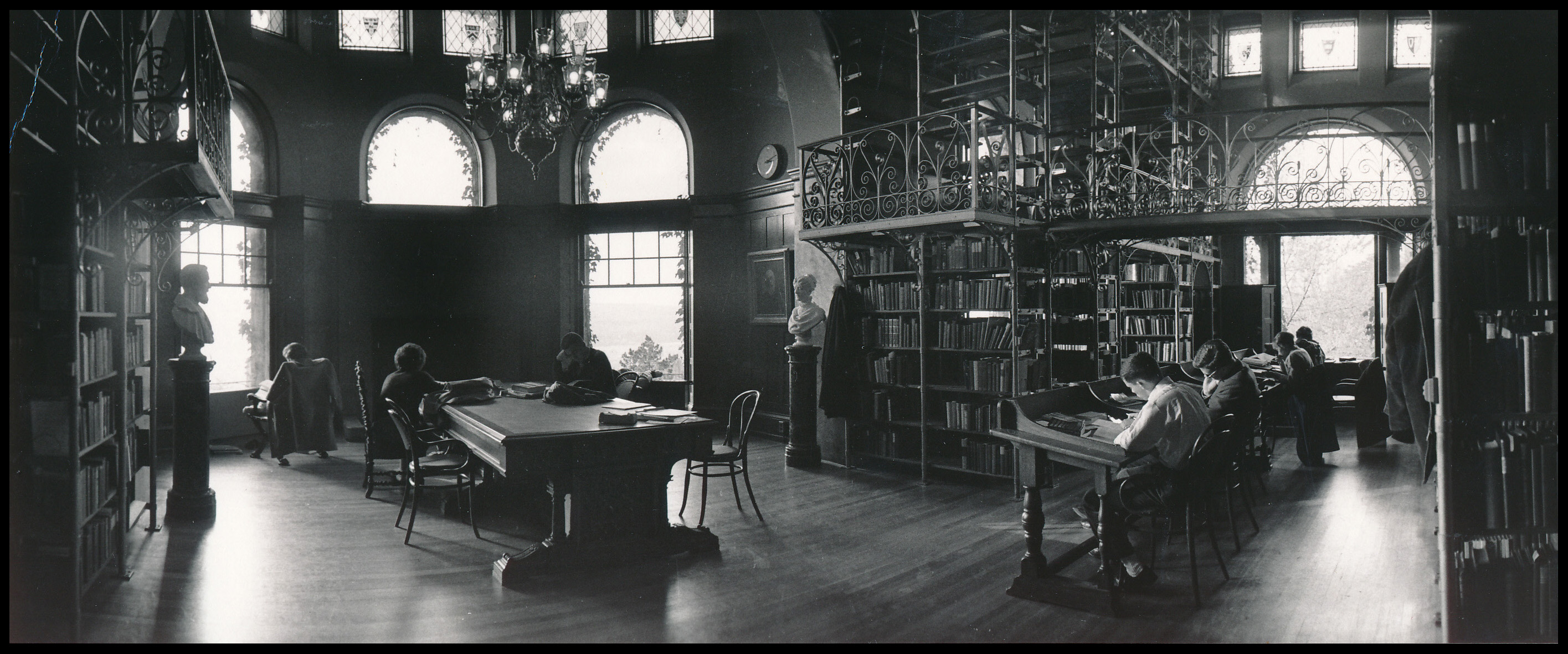 This 1966 photograph shows the White painting on the opposite wall. The artwork and furnishings in the A.D. White Library have moved and changed many times in nearly 150 years.
This 1966 photograph shows the White painting on the opposite wall. The artwork and furnishings in the A.D. White Library have moved and changed many times in nearly 150 years.
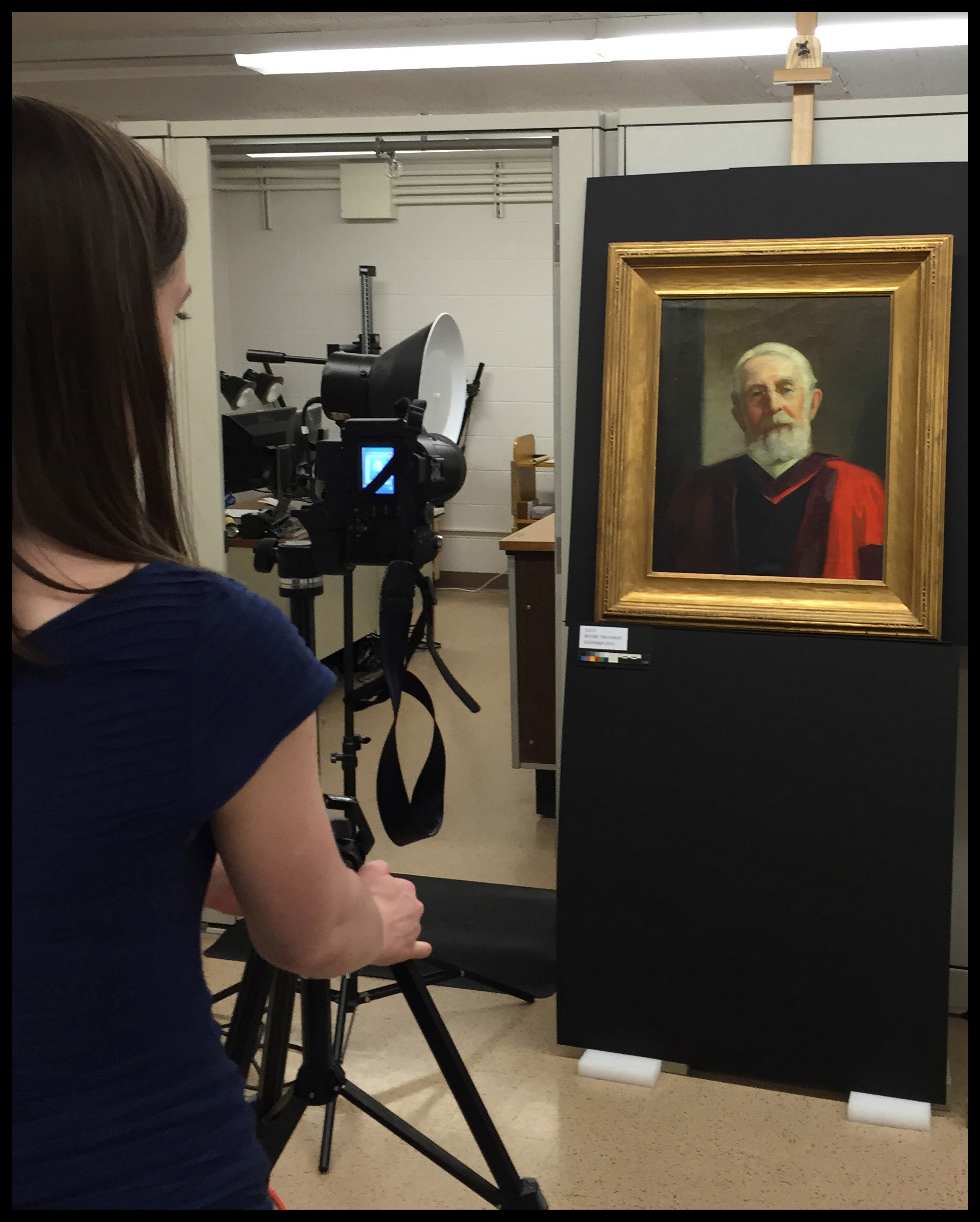 Digital photography captures the condition of the painting and serves as a reference image for future evaluations.
Digital photography captures the condition of the painting and serves as a reference image for future evaluations.
Rachel, who is pursuing art conservation after graduating from Cornell this spring, executed a skillful cleaning of both the painting and frame. Rachel gained valuable experience treating this painting and helped preserve it for Cornellians and visitors to enjoy.
 After determining that the paint surface is intact, Rachel passes a HEPA vacuum, which has gentle suction and a dedicated soft brush, lightly over the surface. Cotton–tipped swabs were also used to clean the gilt frame.
After determining that the paint surface is intact, Rachel passes a HEPA vacuum, which has gentle suction and a dedicated soft brush, lightly over the surface. Cotton–tipped swabs were also used to clean the gilt frame.
The oil painting of George Lincoln Burr, by Christian Midjo, was too large to be moved to the conservation lab. So, on a quiet day before the Spring semester, we assessed and cleaned the painting in situ in the A.D. White Library. Christian Midjo was an art professor at Cornell and an accomplished portrait painter. George Lincoln Burr, Midjo’s subject in this 1921 painting, was a history professor at Cornell and A.D. White’s personal librarian.
 Midjo painted Burr in an unusual pose, showing him pausing during a lecture and looking out intently to his class. His head covers the portion of the map of Europe that was most devastated in World War I.
Midjo painted Burr in an unusual pose, showing him pausing during a lecture and looking out intently to his class. His head covers the portion of the map of Europe that was most devastated in World War I.
 The Burr painting used to hang over the front entrance of the A.D. White Library, as seen in this early photograph.
The Burr painting used to hang over the front entrance of the A.D. White Library, as seen in this early photograph.
 Before renovations in the 20th century, the north wall, where the Burr painting now hangs, was an open archway into the adjacent Dean Room of Uris Library, as seen in this early cyanotype.
Before renovations in the 20th century, the north wall, where the Burr painting now hangs, was an open archway into the adjacent Dean Room of Uris Library, as seen in this early cyanotype.
Our HEPA (high efficiency particulate air) filter conservation vacuum, which traps dust onto the filter and doesn’t blow it back out into the room like a conventional vacuum, was the perfect tool to give this painting a gentle cleaning. We assessed the paint surface and the frame to ensure they were stable and determined the paint surface to be in excellent condition and firmly attached to the canvas. The frame has a few small losses of decorative elements, typical of large, ornate frames nearly 100 years old, but otherwise is in stable condition. After vacuuming removed much of the dust we also used soft conservation sponges to dislodge dirt from the carved elements on the frame. After treatment, the painting was greatly improved in both appearance and condition.
 Close work, such as surface cleaning, allows us to detect condition issues, such as this small puncture seen in the detail of the Burr painting. This detail also shows Midjo’s impasto technique that creates thickly textured paint.
Close work, such as surface cleaning, allows us to detect condition issues, such as this small puncture seen in the detail of the Burr painting. This detail also shows Midjo’s impasto technique that creates thickly textured paint.
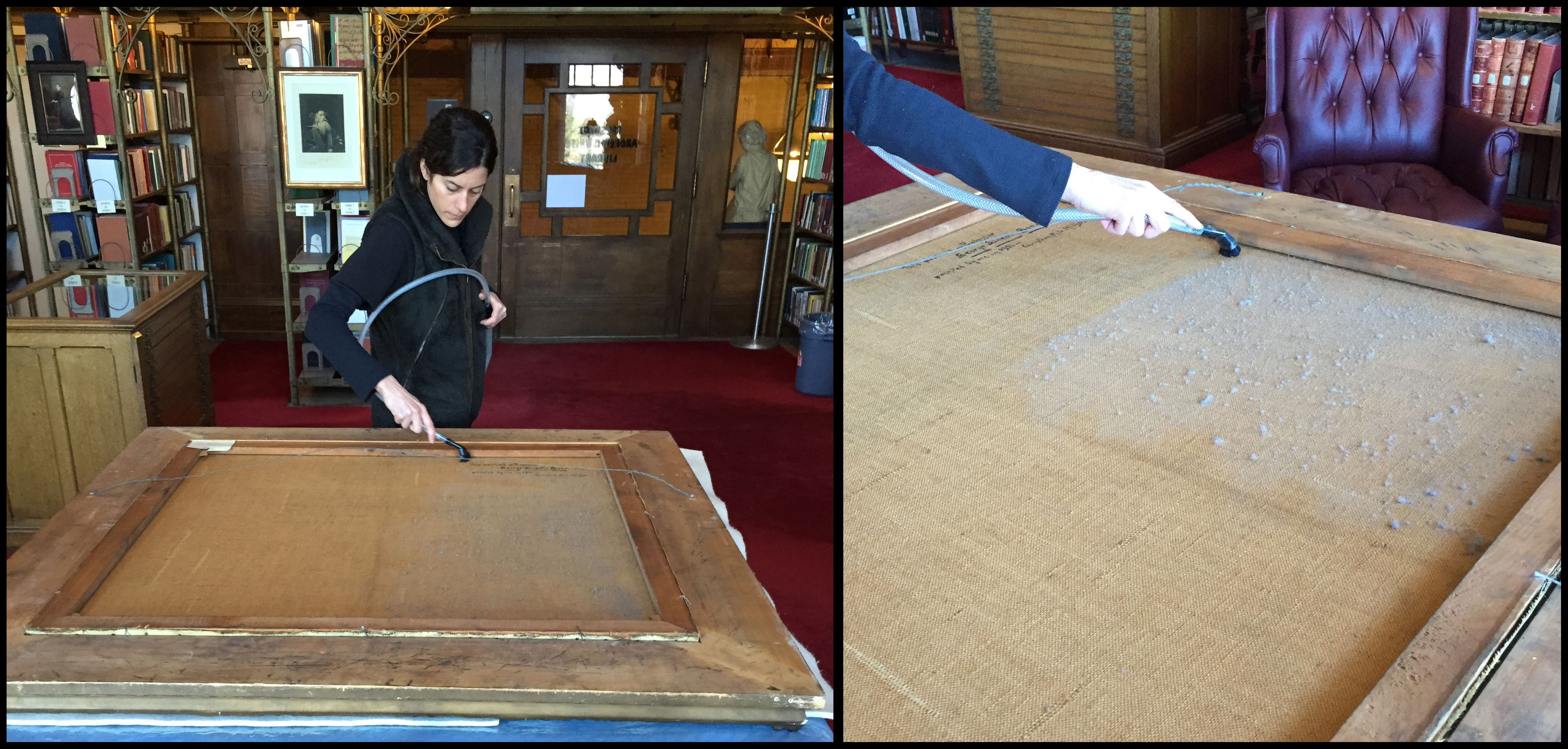 The back of the Burr painting had a noticeable layer of dust, possibly related to a nearby heating unit. Along with our Facilities staff we are investigating deflectors for the heating units to direct air and heat away from the paintings.
The back of the Burr painting had a noticeable layer of dust, possibly related to a nearby heating unit. Along with our Facilities staff we are investigating deflectors for the heating units to direct air and heat away from the paintings.
 In addition to signing the painting on the lower right corner of the front, Midjo also wrote an inscription on the back, seen here before and after cleaning. The canvas support Midjo used has a distinct, nubby texture like that of burlap.
In addition to signing the painting on the lower right corner of the front, Midjo also wrote an inscription on the back, seen here before and after cleaning. The canvas support Midjo used has a distinct, nubby texture like that of burlap.
The A.D. White Library has such historic significance to Cornell. Students enjoy its quiet beauty as they study and alumni remember it with great fondness. A project like Bring Light to A.D. White gives us the opportunity to enhance our spaces to meet the needs of our students, care for Cornell’s collections and preserve the Library that A.D. White described as “the heart of the University”. We have 2 more paintings to surface clean in the coming months–the portraits of Andrew S. White and Mrs. Andrew S. White, which are mounted high on the walls (I see ladders in our future!) Check back for updates on that work, as well as the new light fixtures and carpeting slated to be installed.
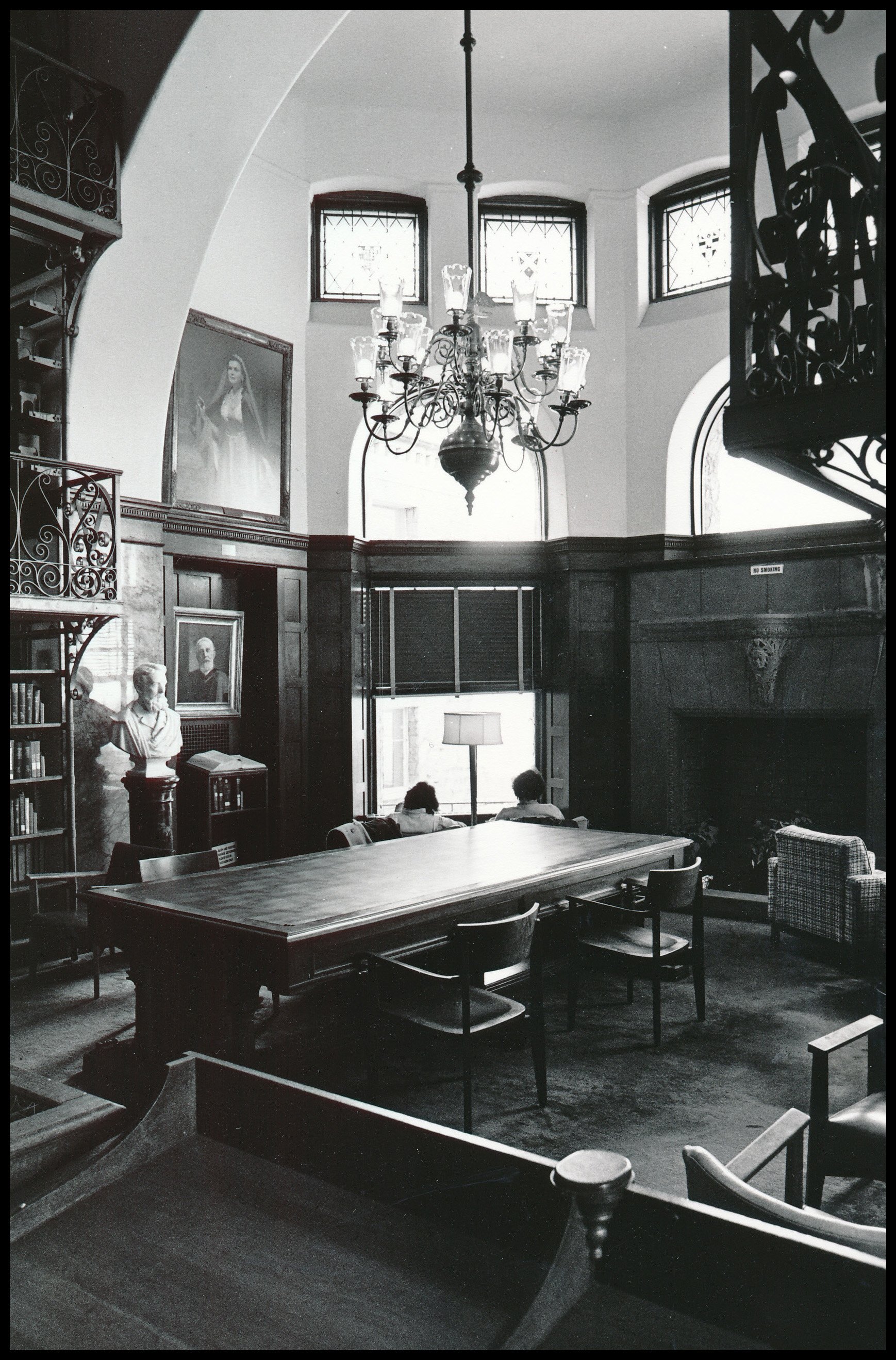 The portrait of Mrs. Andrew S. White hangs near the arched windows as seen in this photograph, likely from the 1970’s. Note the No Smoking sign over the fireplace.
The portrait of Mrs. Andrew S. White hangs near the arched windows as seen in this photograph, likely from the 1970’s. Note the No Smoking sign over the fireplace.
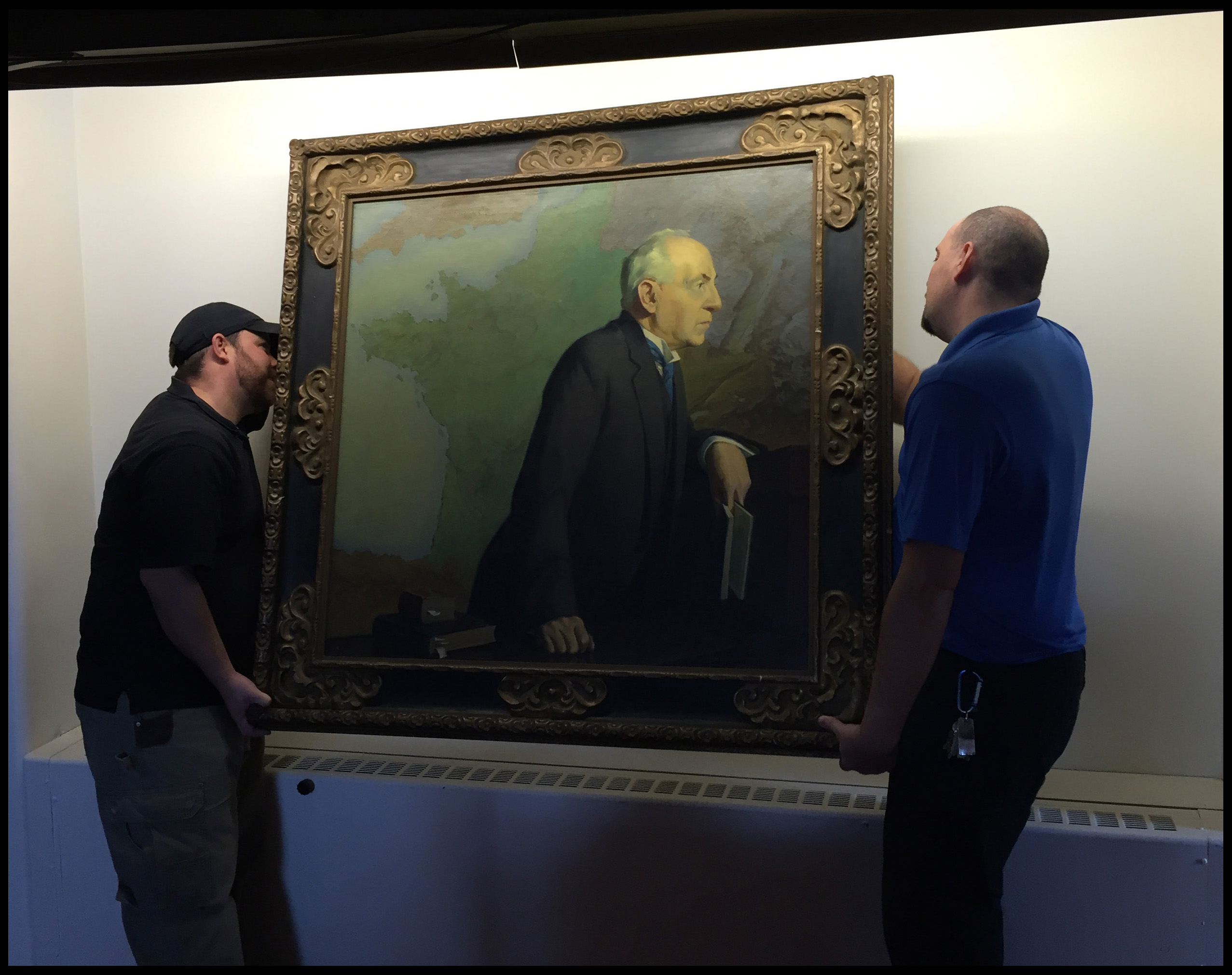 Thank you to Ronnie Clark and Adam Spry, CUL Facilities, for their expert assistance on our conservation projects in the A.D. White Library.
Thank you to Ronnie Clark and Adam Spry, CUL Facilities, for their expert assistance on our conservation projects in the A.D. White Library.